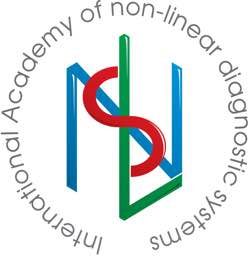ACTUAL ASPECTS OF NLS-DIAGNOSTICS journal is the official information unit of the International Academy of non-linear diagnostic systems. (Media organisation registration certificate El No FS77-52133 from 11.12.2012)
Basic capacity: 32-96 pages
Publication frequency: 4 times per year
Language: English
ACTUAL ASPECTS OF NLS-DIAGNOSTICS is the professional medical journal.
Latest news about NLS-diagnostic systems market, research and practice articles on topical question of NLS-diagnostics for general practitioners, therapists, surgeons and specialized doctors. Regular columns for scientists and medical students.
Intended readers: practicing physician of various specializations: surgeons, endocrinologists, cardiologists, rheumatologists, psychoneurologists, pulmonologists, gastroenterologists, E.N.T. specialists, dermatovenerologists, urino-nephrologists, gynecologists and family doctors.
Main subject: the journal has practical orientation and publishes articles created by leading experts and opinion leaders addressing topical issues of NLS-diagnostics of wide nosological range; modern methods and algorithms of non-linear diagnostics of diseases and traumas.
These issues have a particular interest and practical significance for everyday work of therapists and practicing physicians – the intended readers of the journal.
CONTACTS
Editors office:
– Head editor and the project director
Dr. Vladimir Nesterov – full member of the Academy of Medical and Technical Sciences, the President of International Academy of non-linear diagnostic systems, Academician.
v.i.nesterov@inbox.ru
Phone: +7-3812-31-86-97
– Technical editor
Mrs. Lyudmila Yankina
metatron.ipp@mail.ru
Phone: +7-916-112-18-15
– Marketing
Marketing manager
Mr. Vladimir Zabolotskiy
zvp_work@mail.ru
Phone: +7-495-616-66-59
Editors office address:
Bldg.6, 3-1/12, Obukha lane, Moscow, 105064, Russia
Editorial board:
Palosaari T. – Finland
О’Connor J. – USA
Maclane R. – USA
Majer A. – Germany
Vaskes D. – Spain
McMillan G. – Great Britain
Pac I.M. – South Korea
Lebrun V. – France
Lu D. M. – Hong Kong
Kuznetsova T.G. – Russia
Nesterova V.I. – Russia
Ogluzdina N.L. – Russia
Shvack A.Y. – Russia
Shishkovec Т.А. – Belorussia
Shmidt А.H. – Russia
Yablynovskiy А.P. – Russia
Bairakov R.I. – Kazakhstan
Olsen R. – Sweden
Guglya А.F. – Ukraine
Bosancu O. – Romania
Mann V. – Germany
Chung M.H. – Taiwan
Bertolissi A. – Italy
Khaimzon A. – Israel
Masuda T. – Japan
Hancock G. – Australia
INSTRUCTIONS FOR AUTHORS
Manuscript formatting rules
1. A manuscript should be submitted to the editorial office in English, in electronic form via e-mail.
2. Original manuscripts should be formatted in accordance with traditional for world’s scientific publishing plan: sections – materials and methods, results and discussion, clear conclusion must be given, where results of a work and author’s ideas are presented briefly.
3. Title page should contain: manuscript’s title; full name of each contributing author, his/her affiliation, position and academic degree; contact information for publication in free access for further contacts of an author and readers (via e-mail).
4. Manuscripts should be prepared one-and-half-spaced in Microsoft Word or RTF format, using Times New Roman font at 12 points, 2 cm margins, no hyphenation.
5. Text of a manuscript and all quotations should be checked by an author, compared to origins, referenced with mentioning of a page and a year of publishing. Editors office does not send proof sheets.
6. Authors should use only generally accepted abbreviations.
7. No abbreviations should be used in the title. Full term replaced by an abbreviation should be explained at the first mention in a text (standard units and symbols should not be explained). Tables should be in English, they should be titled, be compact and demonstrative, content of columns should correspond to their titles. All numbers in tables should correspond to numbers in a text.
8. All unit of measurement (physical quantities, haematological, biochemical and other units used in medicine) should be of the metric system (International System of Units – SI).
9. All mentioned in a manuscript medications and medical accessories must have valid registration in EU. Only international names of medications should be used. Exceptions are: combined, multi-component medications, preparations of herbal or animal origins.
10. Pictures, diagrams and images with image-related text should be submitted separately. Accepted formats are TIFF, JPEG with minimum compression ration 8, resolution 300 dpi, size 6×9.
11. No hyperlinks should be used in a manuscript.
12. References should be placed after a text of a manuscript. Author is responsible for accuracy of given information. Total number of references should not exceed 30 entries.
13. All manuscripts submitted to editorial office are subjected to multi-stage revision. After all revisions are completed the editorial board accepts (or declines) a manuscript for publishing.
14. The editorial board reserves a right to decline a manuscript at its own discretion. Declined manuscripts are not returned to authors. Priority of publishing is set in accordance with editorial plan of the journal.
15. The editorial board reserves a right to cut and modify contents of a manuscript regardless of its volume, including changing of a manuscript’s title, terms and definitions. Lesser corrections of stylistic, nomenclative or formal character are introduced into a manuscript without securing approval of an author.
16. Submission of manuscripts already submitted to other editorial offices or already published in other journal is not allowed.
SECTIONS AND COLUMNS OF THE JOURNAL
– Editor’s column;
– Topical reviews on certain fields and issues of NLS-diagnostics;
– Conferences, notifications about completed and future conferences;
– Modern equipment for NLS-diagnostics;
– Columns for specialized doctors; NLS-diagnostics in:
– Bronchopulmonology;
– Gastroenterology;
– Gynecology;
– Homeopathy;
– Dermatovenerology;
– Immunology and allergology;
– Cardiology;
– Cosmetology;
– Naturopathy;
– Threpsology;
– Oncology;
– Orthopedics and traumotology;
– Otorhinolaryngology;
– Ophthalmology;
– Psychoneurology;
– Rheumatology;
– Sports medicine;
– Dentistry;
– Nephrology;
– Surgery;
– Endocrinology.
